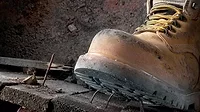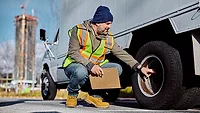Safety Tips for Using Aerial Lifts on Restoration Jobs
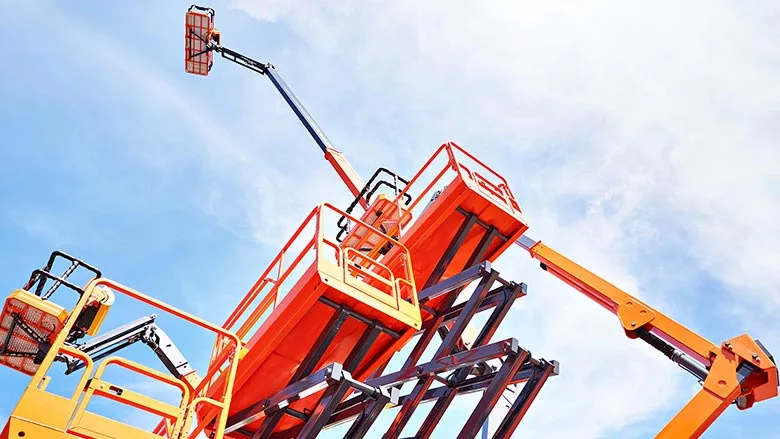
Photo: sergeyryzhov / iStock / Getty Images Plus via Getty Images
Restorers at times need to perform work at heights that are not easily reached by a ladder or can’t be performed efficiently from a ladder. That work can range from demolition to cleaning to possibly even mold remediation. Two common options to perform that work at height are scaffolds and aerial lifts. Both options have unique hazards and OSHA training requirements that must be followed. In this article I am going to focus on the safe operation of aerial lifts and cover the following:
- Types of aerial lifts
- Fall Protection requirements
- Training requirements
- Inspections requirements
- Aerial lift limitations
Types of Aerial Lifts
I will keep this very basic:
- Scissor Lifts
- Boom Lifts
Scissor lifts have a platform with railings that sits directly over the frame and wheels of the machine. The “scissors” part of it refers to the mechanism that raises and lowers the platform. In its most common form, a scissor lift is battery powered and operated from a controller on the platform. Workers access the platform through an end section that has a gate or chain to prevent the user from falling out. Most scissor lifts look something like this:
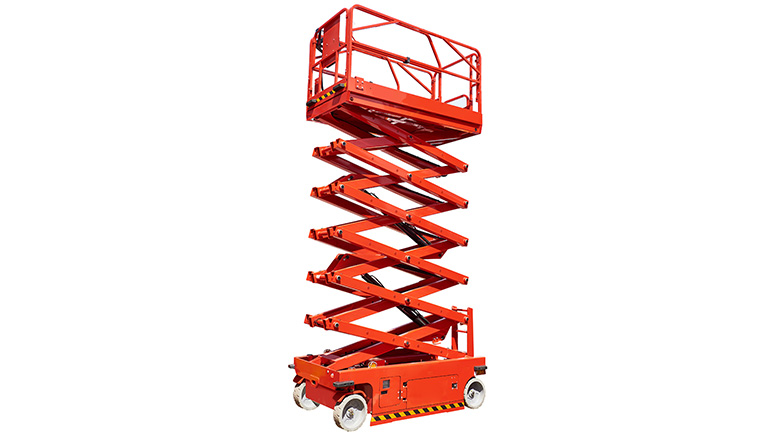
This configuration of scissor lift is operated on hard surfaces and inside a building or around paved building exteriors. Other configurations exist that will operate on rough terrain and can carry over 2,000 pounds in the platform.
Boom lifts are an altogether different machine. In their most common form, there is a base machine with 4 large tires and a gas or diesel engine. The machine has a turret that allows it to spin and a basket attached to a boom. Most boom lifts look something like this:
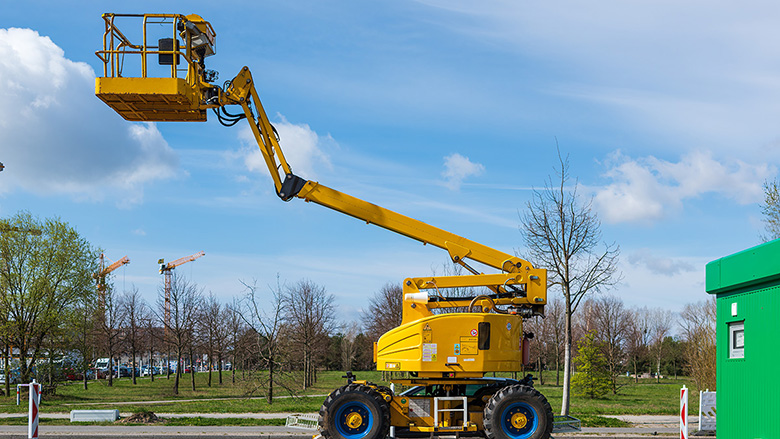
Most boom lifts can be operated on hard or soft surfaces and are generally not operated indoors due to the engine exhaust. They are great for access to building exteriors and roofs.
I have oversimplified the types of aerial lifts available for the sake of writing a short article. There are a huge amount of variations of scissor and boom lifts. Some scissor lifts are very small while others are quite large with off-road capability. Likewise, boom lifts can vary with many types of articulating booms, baskets, and very high reach (>100 feet), while there are also vertical lifts that can be pushed through a doorway.
Fall Protection Requirements
The most common question I receive on aerial lifts is the OSHA fall protection requirement. Most people believe one of two extremes – all lifts require fall protection or no lifts require fall protection. Neither of these beliefs are correct! Simply stated, here are the requirements:
- Scissor lifts do not require the user to wear a harness and lanyard (1)
- Boom lifts do require the user to wear a harness and lanyard (2)
Let’s go into this a little further. In a scissor lift, the railing around the platform is considered the fall protection. There is a top rail, mid-rail, and toe kick – they serve as the protection from falling out of the lift. Think along the lines that a scissor lift basket is like a scaffold; your fall protection is built in. Of course, there are a couple other details:
- A scissor is only to be operated with the basket down, which minimizes the fall distance.
- Scissor lifts have automatic stabilizers than deploy when the basket goes up.
For the boom lifts, there is more risk because the boom acts like a lever or catapult anytime the tires strike something, fall into a hole or rut, or the lift tips over. The further out the boom is, the greater the catapult effect. This can result in the user being ejected out of the basket. OSHA requires a harness and lanyard to arrest the fall of the user, should he or she be catapulted/ejected out of the basket. In a tip over, the harness and lanyard may not help a lot.
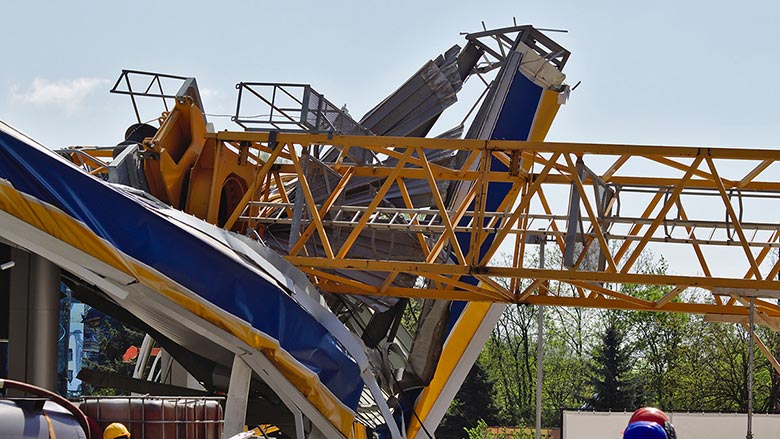
For consistency purposes between lifts, a Restoration Company can certainly require the user(s) to wear a harness and lanyard on any lift. This would obviously be more conservative than the OSHA requirement; however, I see this applied frequently. It simplifies the jobsite requirements – if you go up in a lift, you wear a harness and lanyard. Consider your situation and apply what works best for you.
Training Requirements
Training for aerial lift operators and workers is the same, whether the person is driving or riding along in the basket. OSHA identifies specific training requirements in 1926.454 and mentions the need for the trainer to be qualified (3). A word of caution – for most companies, this is not a DIY training event. However, the solution is relatively easy. I have found that the lift rental companies have very good training content, knowledgeable trainers, excellent materials, and are up-to-date on the latest machines. That’s part of the beauty of using a rental company for training; they are familiar with newest machines because they rent them and their drivers operate them when loading and unloading. See some of the rental companies I am familiar with in the Resources Section at the end of this article.
Inspection Requirements
This is a key OSHA requirement for the day-to-day operation of an aerial lift – inspection before use. (4) You want to make sure all functions of the lift are operational before you go up in the air and discover a problem! Your training course will go over this in detail and likely provide you with some inspection sheets. I have found that most aerial lift manufacturers have inspection sheets for their equipment on their website.
Aerial Lift Limitations
We already know that lifts can get you to places that ladders can’t and do so much more efficiently. However, every machine has limitations. Here are a few that immediately come to mind for aerial lifts:
- Uneven, very rough, or steep terrain
- Physical barriers that can’t be maneuvered around
- Physical barriers that prevent close access to the work area
- Power lines or building features that a lift would strike
The possibility of these limitations being on your jobsite make it necessary to evaluate your work area before operating a lift. Somebody needs to walk the area and look around…..preferably somebody who is trained and has aerial lift experience. If you don’t have somebody that can do that, reach out to your local rental company and get a representative to come out to walk your jobsite.
Summary
Aerial lifts provide a distinct advantage over ladders and scaffolds in many situations. Plus, I think they are a blast to operate! However, they are a machine and every machine has limitations. If you are going to use a lift on your next restoration job, be sure to have trained operators and follow the basic information that I have just covered. I wish you safe and profitable use of aerial lifts!
Resources
- The American National Standards Institute (ANSI), ANSI/SAIA A92.22-2021. https://webstore.ansi.org/standards/sia/ansisaiaa92222021-2458431
- Occupational Safety and Health Administration, OSHA Quick Card, Aerial Lifts, OSHA 3267-04R-13. https://www.osha.gov/sites/default/files/aerial_lifts_safety.pdf
- Occupational Safety and Health Administration, OSHA Fact Sheet, Aerial Lifts, DSG 4/2011. https://www.osha.gov/sites/default/files/publications/aerial-lifts-factsheet.pdf
- Sunbelt Rentals Training https://www.sunbeltrentals.com/training/safety/
- JLG Training https://www.jlg.com/en/training
- United Rentals, United Academy https://www.unitedrentals.com/training#/
References
- Occupational Safety and Health Administration, Standard Interpretations, 2000-08-14-0. https://www.osha.gov/laws-regs/standardinterpretations/2000-08-14-0 and 1926.451(g)(1)(viii). https://www.osha.gov/laws-regs/regulations/standardnumber/1926/1926.451
- Occupational Safety and Health Administration, 1926.453(b)(2)(v). https://www.osha.gov/laws-regs/regulations/standardnumber/1926/1926.453
- Occupational Safety and Health Administration, 1926.454, Training requirements. https://www.osha.gov/laws-regs/regulations/standardnumber/1926/1926.454
- Occupational Safety and Health Administration, 1926.453(b). https://www.osha.gov/laws-regs/regulations/standardnumber/1926/1926.453
Technical Note
A few years back, ANSI replaced the term aerial lift in its A92 standard with Mobile Equipment Work Platform (MEWP). Technically I should have used MEWP throughout this article. I chose to stay with aerial lift due to its common recognition.Looking for a reprint of this article?
From high-res PDFs to custom plaques, order your copy today!





